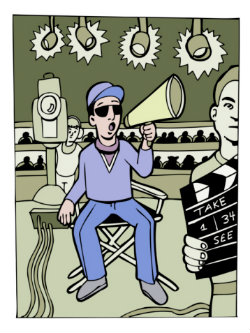Editor’s Note: This article originally appeared on the Grantmakers In Health website. For more information about the Letter of Intent process and to discover whether the SIF opportunity is right for your organization, please join us for a one-hour, broadcast webinar on Tuesday, November 27, 2012, 10am Pacific Time. Registration for the webinar is free.
 Like many members of Grantmakers In Health, we have worked for many years to improve the quality and lower the costs of health care—in our case focused on older Americans in particular. We have funded demonstrations of innovative models of care for geriatric conditions, and we have learned that changing how care is actually delivered is a lot like the movie business. You have to have a concept, a script, talent, partners, and money to make a movie, but making the movie is only the start. Having made a movie, there are still gigantic, if less obvious, challenges to bringing it to theaters across the country—there are significant investments required to market a movie and make it into a blockbuster.
Like many members of Grantmakers In Health, we have worked for many years to improve the quality and lower the costs of health care—in our case focused on older Americans in particular. We have funded demonstrations of innovative models of care for geriatric conditions, and we have learned that changing how care is actually delivered is a lot like the movie business. You have to have a concept, a script, talent, partners, and money to make a movie, but making the movie is only the start. Having made a movie, there are still gigantic, if less obvious, challenges to bringing it to theaters across the country—there are significant investments required to market a movie and make it into a blockbuster.
One of our top "concepts" is better depression care for older patients. Depression is one of the most common disabling and debilitating health conditions in the United States and internationally. In older adults, depression often co-occurs with chronic medical diseases, complicating clinical care. While anti-depressant drugs are some of the most commonly prescribed (and advertised) in the United States, most people’s care still does not follow best practice guidelines and therefore does not produce the full benefits of treatment. Non-pharmaceutical therapies are also effective but can be hard to find and afford. More than 15 years ago we realized that this is not a “mental health” specialty issue, as the majority of depressed people and especially older adults are (and wish to be) diagnosed and treated in primary care settings by their generalist providers. Nor is the overburdened specialty mental health system capable of providing this care. This is a chronic disease issue that calls for a prepared and proactive primary care practice and an engaged patient.
Unfortunately, most primary care practices are ill-equipped for this kind of chronic care and, as a result, only about 20 percent of patients treated for depression in primary care are significantly improved a year later. Recognizing this paradox, the U.S. Preventative Services Task Force (USPSTF), does NOT recommend screening for depression in primary care UNLESS the practice has an evidence-based systematic approach to follow-up and treatment. (Imagine if the USPSTF made a similarly hedged recommendation about screening for hypertension . . .)
To change this situation, our "script" has been the Improving Mood – Promoting Access to Collaborative Treatment (IMPACT) model for treating depression in primary care. IMPACT uses a team approach in which the patient and primary care provider receive support for evidence based care from a disease management clinical specialist (such as a specially trained nurse, social worker, or psychologist) and a system of planned care. An on-line tracking and reminder system supports close follow-up of depressive symptoms and ensures that patients receive revisions of the treatment plan as needed. IMPACT engages patients in their own care, systematically measures improvements in their mood, and builds-in regularly scheduled provider-to-provider consultation with a psychiatrist. Research shows that this collaborative, team-based approach results in twice as many patients achieving significant improvement in their symptoms as in usual care. To date, IMPACT has been adopted by more than 600 practices, health plans, and other provider organizations.
 Our "talent" has included many stars, but top billing goes to our long-time grantee – now known as the Advancing Integrated Mental Health Solutions (AIMS) Center at the University of Washington, directed by Jürgen Unützer, MD, MPH. Dr. Unützer not only directed the $10,000,000 multi-site, randomized clinical trial to demonstrate the benefits of the IMPACT model on clinical and cost outcomes, but also worked tirelessly on the less glamorous but even more important work of taking the results from the pages of The Journal of the American Medical Association or British Medical Journal and making them available around the country.
Our "talent" has included many stars, but top billing goes to our long-time grantee – now known as the Advancing Integrated Mental Health Solutions (AIMS) Center at the University of Washington, directed by Jürgen Unützer, MD, MPH. Dr. Unützer not only directed the $10,000,000 multi-site, randomized clinical trial to demonstrate the benefits of the IMPACT model on clinical and cost outcomes, but also worked tirelessly on the less glamorous but even more important work of taking the results from the pages of The Journal of the American Medical Association or British Medical Journal and making them available around the country.
Our partners have included The California HealthCare Foundation, Hogg Foundation for Mental Health, and the Robert Wood Johnson Foundation for our original randomized controlled trial of the collaborative care treatment model, and The Fan Fox and Leslie R. Samuels Foundation, National Institute of Mental Health and Centers for Medicare and Medicaid Services for the dissemination and implementation phases of this initiative.
Despite having an excellent product like IMPACT, large-scale, real world change is still very hard. Change in health care is slow at best, even for “easy” changes like the introduction of new medications. Change at the practice redesign level requires time, thoughtful marketing, multiple communications opportunities, and serious external support (just as the philanthropic community is learning with regards to the “medical home” model). Compared to film distribution, which can saturate advertizing channels, put marketing tie-ins in every McDonald's, and get a print to thousands of screens for opening night, we just don't have the infrastructure, the experience, or the money.
We learned from Dr. Unutzer the saying, “It costs more to market the movie, than to make the movie.” We have still not lived up to this standard in our support of post production “marketing,” but through our newest (distribution) partnership we finally will.
New Distribution Partners:
Leveraging Government Support
 We are proud to have been awarded one of four grants in 2012 from the Social Innovation Fund (SIF), part of the federal Corporation for National and Community Service. In this public-private partnership program, an intermediary organization (such as ourselves) applies for matching funding from the SIF to spread innovative practices that solve important social problems, such as IMPACT. We then are responsible for re-granting the pooled funds to local sites that will be adopting the model, along with contracting for technical assistance and evaluation services to ensure fidelity.
We are proud to have been awarded one of four grants in 2012 from the Social Innovation Fund (SIF), part of the federal Corporation for National and Community Service. In this public-private partnership program, an intermediary organization (such as ourselves) applies for matching funding from the SIF to spread innovative practices that solve important social problems, such as IMPACT. We then are responsible for re-granting the pooled funds to local sites that will be adopting the model, along with contracting for technical assistance and evaluation services to ensure fidelity.
Our plan, designed with AIMS, will target the five, largely rural states for which the University of Washington is the only medical school: Washington, Wyoming, Alaska, Montana, and Idaho. Across this region (constituting almost 30 percent of the U.S. landmass), we will make awards to five to eight community health centers to adopt the model. Over time, we expect that our local bastions of innovation will both sustain the work they have started and spread the model further across the region.
Under our award, our money and federal funds match one-to-one and then are subject to a second one-to-one match at the sub-grantee level. Thus, our contribution of $3 million over three to four years will be matched by $3 million from the federal government (contingent upon a planned renewal, the availability of funds, and satisfactory performance). Our awards to sub-grantees totaling some $4.5 million (less the core costs of technical assistance and program evaluation) will require a matching $4.5 million from other sources, such as additional local or national funders, resulting in a project totaling $10.7 million.
Coming Attractions
In the long-run, we hope that many more places adopt IMPACT and make it the standard approach to the delivery of mental health services in primary care for older patients. We also hope to influence how primary care practices use teams to implement evidence-based care for chronic conditions more generally. Through implementing models such as IMPACT, these practices can enhance the quality of care, improve the health of the population, and lower per-capita health care spending. This kind of transformation and these kinds of outcomes will no doubt take time, but we look forward to continuing to market this “movie” and others like it until they are in "theaters" everywhere.
